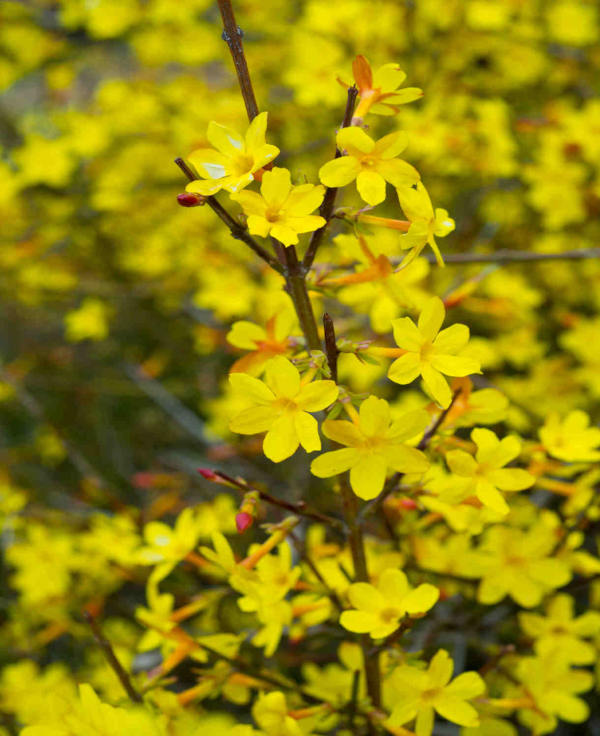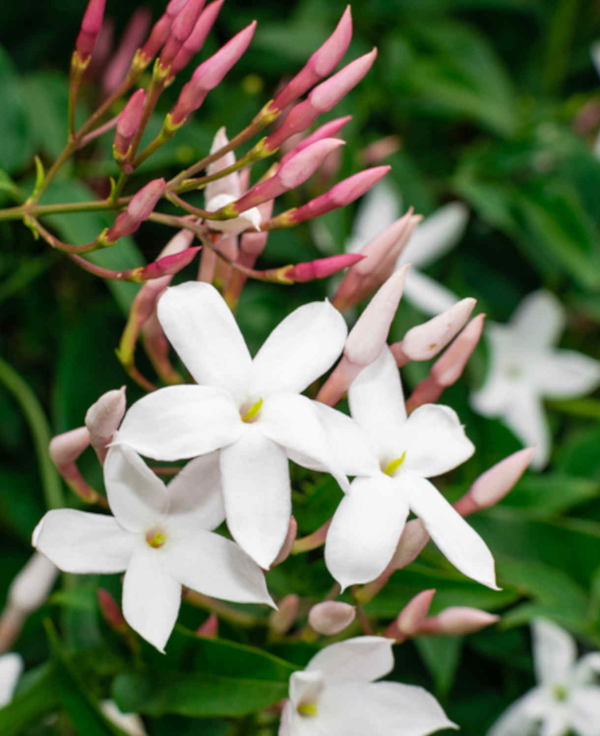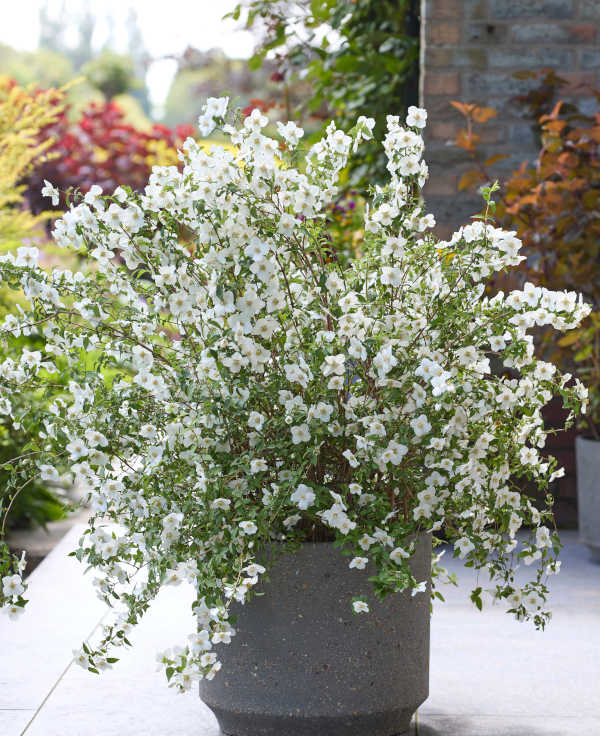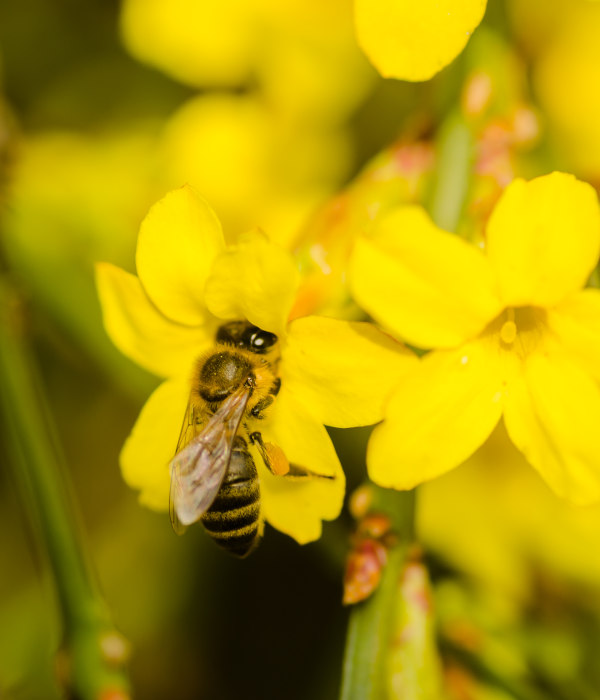How to grow Jasminum
There are over 200 species of deciduous and evergreen shrubs and climbers found in this well-known member of the olive family, all of which have star-shaped, often sweetly scented flowers. Many of the twining climbers tend to flower in summer, while those with a more scrambling, bushy habit are usually winter flowering. There are also several tender or half-hardy species commonly grown as houseplants in the UK.

Zantedeschia is a genus of flowering plants from the family Araceae and is native to southern Africa. With a rich history dating back to the Ancient Romans, these deciduous or semi-evergreen perennials have been used as a symbol of celebration. Zantedeschia was Named after Professor Giovanni Zantedeschia, an Italian botanist.
There are two main forms of Zantedeschia: hardy and tender. Hardy forms of the plant can be grown outdoors, enjoy moist soil and full sun or partially shaded conditions - these are known as Arum lilies. Tender forms of Zantedeschia prefer being grown in containers or pots and should be brought inside over the winter - these are known as Calla lilies.
With tuberous flora in all colours from whites, yellows and oranges to deep reds and purples, Zantedeschias are not to be overlooked in any garden, as long as they have sufficient sunlight to grow in.
Ready to learn more about growing Zantedeschia? Read on for all there is to know...

Key Information
Soil pH
Position
Hardiness

Species | Foliage | Hardiness | Plant type (in UK) | Flowering period | |||
Deciduous | Evergreen | Semi-evergreen | Outdoor | Houseplant | |||
Jasminum beesianum |
|
| ü | H5 | ü |
| Summer |
J. humile |
|
| ü | H5 | ü |
| Summer |
J. laurifolium |
| ü |
| H3 |
| ü | Late spring to autumn |
J. officinale | ü |
|
| H5 | ü |
| Summer |
J. x stephenense | ü |
|
| H5 | ü |
| Summer |
J. nudiflorum | ü |
|
| H5 | ü |
| Winter and early spring |
J. polyanthum |
| ü |
| H2 |
| ü | Late winter and spring |

Where & when to plant Jasminum
Position- Summer flowering jasmines enjoy a warm, sheltered spot, whereas winter flowering jasmines can cope with a colder location.
Most species will tolerate partial shade (particularly winter jasmines), though all do best in full sun.
Soil- Fertile, well-drained soil of any pH.
Flowering Period- Can be winter, spring, summer depending on the species (see below)
Hardiness- Varies depending on the species (see below)
For best results, plant summer flowering jasmine in autumn or spring. An autumn planting can be done by those gardening in mild conditions (and broadly speaking, this is the southern half of the UK). For those liable to cold winters, it is best to wait until spring (generally the northern half of the UK). Planting can also be carried out in summer, though be prepared to water regularly.
Winter flowering jasmine is best planted in autumn and winter, and the tender indoor varieties do well potted up in spring or early summer.
Hardier varieties are perfect for covering a wall or fence and are best located near to a door or seating area to allow fullest enjoyment of their delicate beauty and fragrance. They can be grown either in the open ground or a large pot, in both cases needing sturdy support in the form of wires or a trellis. The more tender species are best in containers for use as houseplants or in the conservatory, with either canes or a small, metal support designed especially for pots.
How to plant Jasminum
N.b., when planting a climbing jasmine, it is best to install the support (wires, trellis etc.) prior to planting. Then:
- For planting in the garden, dig the soil area removing any large stones and weeds and breaking up any lumps. Mix in some organic matter such as manure or garden compost, and, if your soil is on the heavy side, now is also the time to add a generous helping of horticultural grit. Rake level and firm with your heels. Rake level again.
- Water plants well and allow to drain before planting.
- A good tip is to dig a hole twice the size of the root-ball. Fill with water and allow to drain before placing in the plant.
- Place the plant in the hole, ensuring the top of the root ball sits level with the surface of the soil. Too low and the plant may rot, too high and the roots can dry out.
- Backfill with soil and firm in gently with your foot.
- For climbers, insert an angled cane at this stage to encourage the plant to grow towards the support. Tie stems to the cane and/ or support using garden twine.
- Soak well with water.
- Mulch around the base with well-rotted organic matter.
- As growth progresses, tie into the supports as required. Stems close to the support will naturally cling on, but those further away will need a little help.
- For planting in containers, first choose an appropriately sized pot. The best practice is to start just a few centimetres larger than the rootball and increase in size every year or two. Always ensure there are plenty of drainage holes in the bottom.
- If you are using a large or heavy pot, it can be a good idea to fill and plant it in situ to save yourself the trouble of moving once full.
- Use a good quality potting compost with plenty of horticultural grit mixed in, and, if not already present in the compost (check the description on the bag) some slow-release fertiliser granules.
- Start by partially filling the pot with compost; enough so that when placed on it the upper surface of the root ball is about 3cm lower than the top of the pot.
- Infill all the space surrounding the root ball with compost, firming down with your fingers then adding a little more so the plant is held tight.
- Pick up the container and lightly tap on the potting bench or ground a few times to help further settle the compost around the plant.
- Soak well with water.
- A mulch with horticultural grit will look attractive and help to prevent a ‘cap’ or crust forming on the top of the compost (something container plants can suffer due to the artificial nature of their watering).
- For outdoor climbing species, position next to the vertical support and place an angled cane in the container to guide growth in the right direction. Indoor climbing species should, at this point, have canes or a metal support inserted into the compost.
- As growth progresses, tie into the supports as required. Stems close to the support will naturally cling on, but those further away will need a little help.

What to plant with Jasminum
While jasmine is a beautiful plant, it is the fragrance that often draws us in. For an olfactory extravaganza, try combining summer flowering varieties with other highly scented companions. Imagine a courtyard or seating area filled with the aromas of honeysuckle (Lonicera), sweet peas (Lathyrus), mock orange (Philadelphus), phlox, angel’s trumpet (Brugmansia), and lilies. Heavenly!
Hardy winter-flowering jasmine demands neighbours equally as robust and bold in appearance. In our opinion sticking with reds, oranges, and yellows is best when it comes to this plant, as its canary yellow flowers can look jarring and sickly amongst pinks and purples. Think firethorn and the much underrated mahonia, perhaps with some golden variegated English ivy too. Dazzling!
Tender or half-hardy jasmine grown as houseplants create a colourful indoor jungle when paired with other delights such as dipladenia, jacobinia, and abutilon.



How to care for Jasminum
Pruning and Deadheading
It is important to prune jasmines annually to keep them neat and healthy and ensure an even coverage of flowers, as opposed to the straggly bare bottom which can occur when left untouched.
Prune back flowered stems to a strong side shoot lower down, as well as thinning out any weak, damaged, or overcrowded stems. This should be done immediately after flowering, which for summer flowering species means in late summer/ early autumn, and for winter flowering species means in spring.
Watering
During the first growing season in the ground, a good soaking every couple of weeks should ensure long-term success (aiming for consistently moist, but not soggy soil). After this, jasmine requires little watering other than in very hot, dry conditions.
Container-grown jasmines need to be watered regularly throughout every growing season, as their restricted roots have less access to moisture. Allowing the top couple of centimetres of compost to dry out between watering is a useful rule of thumb to help avoid overwatering. Use your finger inserted into the compost to check. Outside, from mid-autumn, the British climate tends to take over watering needs, though do remember to step in in the event of an unseasonably dry spell. Indoors, watering should be reduced to the bare minimum throughout autumn and winter. This means allowing the compost to almost dry out between very light waterings.
Feeding
Jasmines are naturally hungry plants which benefit from regular feeding. As well as a mulch of well-rotted organic matter each autumn (i.e., a layer of manure or garden compost applied around the plant to improve the soil, suppress weeds, and lock in moisture), we recommend a spring dose of general purpose granular feed. This should be applied to the surface of the soil and lightly worked in, also known as a ‘top dress’. During the flowering period, a weekly or fortnightly application of a high potash fertiliser (such as liquid tomato feed) can also boost performance significantly.
In containers, a weekly or fortnightly dose of high potassium liquid feed is recommended (again, a liquid tomato feed is ideal).
Cold Protection
H5 rated jasmines can withstand temperatures of -10°C to -15°C, so should be fine outside even in an average UK winter. Having said that, the summer flowering species grow and bloom best when they are in a warm, sheltered spot, so try not to expose these to cold winds and frosts. Like all plants, those grown in containers can be more vulnerable to the cold, and it can therefore be worth wrapping pots with hessian or fleece during the winter (this will protect the pot from cracking too).
Tender and half-hardy species require the year-round warmth of an indoor location.
Pests and Diseases
Outdoors, jasmines are usually problem free. Inside, the usual issues of spider mite and aphid can crop up. Keeping plants as healthy as possible is the key to warding off problems, and by this we mean proper ventilation, adequately spaced plants (for good air flow), keeping everything well-watered and fed, and repotting into larger containers when necessary. Thoroughly cleaning the indoor environment every winter can also help to remove overwintering populations of pests.
Where infestations do take hold, try introducing biological controls (often sachets or tubes containing miniscule natural predators), or in the worst cases, remove the affected plant/s altogether.
How to propagate Jasminum
Outdoor jasmines are best propagated by taking hardwood cuttings during winter.
- Select shoots of fully ripe, current year growth, cutting at the join with last year’s growth.
- Trim to 15-20cm, with the top cut just above a pair of buds, and the bottom cut just below a pair of buds. It is good practice to make the top cut a sloping one, both to aid water runoff, and to remind you which end is the top.
- Spacing approximately 10-15cm apart, firm into a trench in a prepared bed (with well-rotted organic matter and grit dug in), the top 3-5cm of the cutting showing above soil level. Alternatively insert into containers filled with a gritty compost mix.
- Water in lightly. Place containers in a cold frame or unheated greenhouse.
- Check and re-firm trench cuttings after a frost (which can lift them out of the ground).
- Leave cuttings in place until the following autumn ensuring they do not dry out during the summer. By this point they should have rooted and can be lifted and either potted or planted out as required.
Tender or half-hardy jasmines are better propagated by cuttings taken during spring and summer.
- Find non-flowered shoots 5-10cm long and snip off the plant.
- Put them in a plastic bag straight away to prevent drying out.
- Fill a container with a compost mix which is at least 50% perlite (or if you prefer, as we do, 100% perlite).
- Trim the end of the cutting to just below a node (point at which leaves grow).
- Remove the lowest third of leaves.
- If the remaining leaves are large, cut them in half with a sharp knife (to reduce water lost through transpiration).
- Insert the cuttings into the compost and water lightly. Several cuttings can be put in the same container if there is enough space to do this without them touching.
- Place in a propagating unit with bottom heat if you have one or covered with a plastic bag on a windowsill or in a greenhouse if not (out of direct sunlight).
- Keep the cuttings misted and occasionally watered until they root. You will know this has happened when roots emerge out of the bottom of the container.
- Gently remove rooted cuttings and pot them into individual pots. Grow on in a cool yet frost-free environment such as an unheated conservatory, greenhouse, or cold frame, until they are large enough to be planted out.
* Many plants carry Plant Breeders Rights and cannot be propagated for commercial purposes.
Common Jasminum questions
- Is jasmine easy to grow?
Provided you choose an appropriate location for the species (warm and sheltered for summer flowering; a little colder if you like for winter flowering; indoors for tender/ half-hardy species), you should find jasmine straightforward to grow. The rules for pruning are simple and easy to remember, and as long as you are prepared to tie in growth when needed and feed throughout the growing season, jasmine can be a very rewarding addition to the home or garden. - Can jasmine grow in pots?
Yes, jasmine is suitable for growing in a large container. - How long does it take for jasmine to grow?
Jasmine is fairly fast growing and can be expected to put on around 30-60cm a year. x stephanense is known to be a particularly speedy species. - What is the best fertiliser for jasmine/ how do you keep a jasmine plant blooming?
For plants in the open ground, we recommend a general purpose granular feed in spring, and a weekly or fortnightly dose of liquid tomato feed throughout the flowering period. For those in containers, apply liquid tomato feed every week or two throughout the whole growing season (March to September). See our ‘Feeding’ section above for more information.





